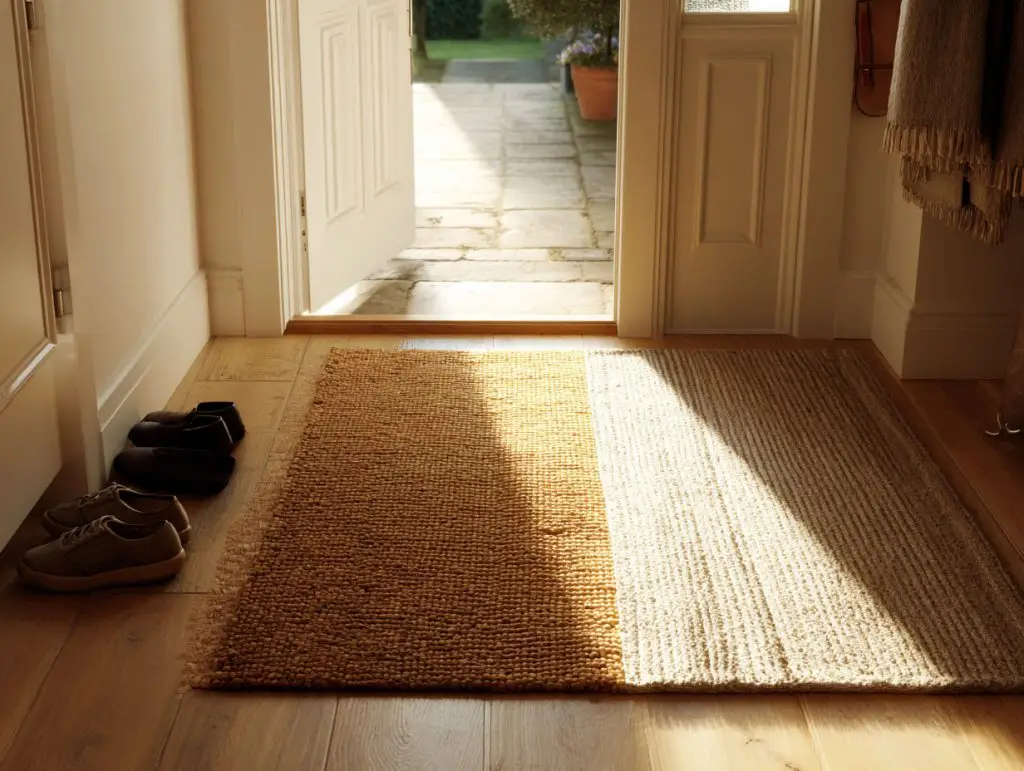
When the Entrance Becomes the Front Line
1. The Season of Wet Footprints
By late October in Destin, the air feels different — heavier, thicker, and always just a little damp.
That’s when the doormats start giving up.
No matter how clean they look, they stop doing their job.
I used to think a doormat was just a rectangle of fabric — a thing you step on and forget.
Until I realized it’s the most hardworking square foot in the entire house.
It meets every kind of dirt before you do — sand, rainwater, leaf dust, dog prints, everything the world brings to your door.
And yet, most people don’t notice it until it fails.
2. The Hidden Mess Under the Mat
The first time I lifted a doormat after a storm week, I was shocked.
Underneath: a thin layer of packed dust mixed with moisture — like a soft clay sheet.
The mat itself was clean, but the floor beneath was quietly decaying.
That’s the part nobody talks about — the dirt that stays loyal.
Every home in this climate has it — even the spotless ones.
Because we forget that doormats don’t stop dirt; they store it.
3. The Illusion of “Outdoor”
People love to buy tough, weatherproof mats that promise to handle everything.
But in a humid place, “outdoor” just means “always damp.”
And damp means mold, trapped salt, and microfilm that starts creeping under the threshold.
Once I saw a client’s entry tile lose its shine completely — not from wear, but from moisture trapped beneath a heavy mat.
It took an hour of careful Sharky cleaning to restore what the mat had quietly stolen.
4. The Lesson That Stuck
Now, when I look at a doormat, I see it like a filter — not a decoration.
And like any filter, it needs cleaning, rotation, and rest.
That’s the Sharky way:
“Every clean house starts one step before the door.”
Because the battle for a fresh home doesn’t begin inside — it begins right where you wipe your feet.
The Sharky Entrance System — Where Cleanliness Begins
1. Step One — Think in Layers, Not in Mats
Most people use one doormat.
Sharky homes use three layers — not because it looks fancy, but because each has a purpose.
- Zone 1: Outside. A rough-textured mat or brush grid — its only job is to scrape.
- Zone 2: Threshold. A medium-weave mat — this one absorbs and traps moisture.
- Zone 3: Inside. A soft, washable mat — for fine dust and that final barefoot feel.
These three layers act like a filtration system: scrape → absorb → polish.
It’s how you stop the outside world before it takes another step in.
2. Step Two — Let Them Breathe
The biggest mistake I see in homes around Destin? Mats that never dry.
Even the best one turns into a sponge if left untouched.
Here’s the Sharky rule:
- Rotate weekly. Every Sunday, swap the inside and threshold mats.
- Air them out for at least 30 minutes in shade, not under direct sun (sunlight stiffens fibers).
- Lift, don’t shake. Shaking just spreads the dust — lift, beat lightly, and vacuum underneath.
A mat that breathes stays useful. One that stays wet becomes part of the mess.
3. Step Three — Clean the Space Beneath
Nobody checks under the mat — but that’s where the real dirt builds up.
Moisture, salt, and micro-dust combine into a thin film that slowly erodes tiles and floor finishes.
Sharky cleaners handle it like this:
- Lift the mat completely once a week.
- Spray the floor lightly with a mix of vinegar and warm water (1:3).
- Wipe, let it dry fully, then replace the mat.
It takes five minutes and prevents months of invisible damage.
4. Step Four — The Drying Zone Ritual
After storms or heavy rain, never trap moisture at the door.
Instead, create a temporary drying zone:
- Roll up your interior mat and hang it vertically for airflow.
- Place a towel or spare mat nearby to catch water for 24 hours.
- Once humidity drops, replace everything in order.
That pause keeps mold away and floors dry — even in the wettest season.
5. Step Five — Know When to Retire a Mat
This is where most people go wrong.
They keep mats long after they’ve stopped absorbing.
The Sharky test is simple:
- Sprinkle a few drops of water — if it pools for more than 5 seconds, the mat’s done.
- If it smells even slightly musty after drying — it’s holding moisture inside.
Good mats last one season in Destin, maybe two.
Beyond that, they stop protecting and start contaminating.
6. The Result — Clean Starts at the First Step
When I follow this rhythm, something subtle happens:
The whole house stays cleaner, longer.
There’s less sand on the floors, fewer smudges, and even the air feels lighter near the door.
Because the truth is simple — the cleaner your entrance, the less you’ll ever have to clean.
That’s the Sharky entrance principle:
“Control what comes in, and you control everything else.”
Read also: When the Light Turns Golden


